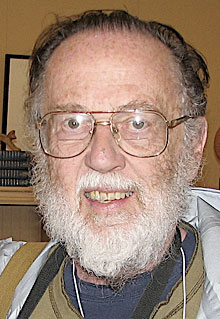Mathematician John Stallings died last year at 73
| 12 January 2009
BERKELEY — John Robert Stallings Jr., a professor emeritus of mathematics at the University of California, Berkeley, who made seminal contributions to geometric group theory and topology, died Nov. 24, 2008, from prostate cancer at his home in Berkeley. He was 73.
 John Stallings (2006 photo by Enrico Le Donne)
John Stallings (2006 photo by Enrico Le Donne)The Poincare Conjecture, proposed by the French mathematician Henri Poincare in 1900, generalizes to all higher dimensions the observation that all two-dimensional surfaces on which every loop can be shrunk to a point without snagging is equivalent to a sphere. Any smooth object without holes is mathematically equivalent to a sphere, while the surface of a teacup, for example, is not, because a loop around the handle cannot be shrunk to a point.
While a National Science Foundation post-doctoral fellow at Oxford University in England in 1960, Stallings heard that UC Berkeley mathematician Stephen Smale had solved the conjecture for five dimensions and higher. For this feat, he won the 1966 Fields Medal, the mathematics equivalent of the Nobel Prize.
"When Smale announced it to the world, it was spectacular," Kirby said. "But Stallings came up with a new proof of a slightly different version of the Poincare Conjecture, for dimensions seven and higher, using a totally different method. This was also remarkable."
The final missing pieces - proof that the Poincare Conjecture holds for three- and four-dimensional surfaces - were proven, respectively, in 2003 by Russian mathematician Grigori Perelman and in 1982 by Michael Freedman. Both men were awarded Fields Medals, though Stallings was not.
Stallings' other main contributions were in geometric group theory, in which geometry and topology (in all dimensions) are used to prove results in algebra, especially in group theory. He was honored for his work in algebra with the 1970 Frank Nelson Cole Prize, which is given every five years by the American Mathematical Society for the best work in algebra.
"He [Stallings] was known for his great originality," former student Benson Farb, now a professor of mathematics at the University of Chicago, wrote in an e-mail. "He most often came up with completely original ideas rather than following up on the ideas of others. His ideas often inspired a great flurry of activity by other mathematicians, though, who would follow up and develop Stallings' methods."
Stallings was born July 22, 1935, in Morrilton, Ark., received his B.Sc. from the University of Arkansas in 1956 and earned a Ph.D. in mathematics from Princeton University in 1959 under the direction of Ralph Fox. He was an instructor and then a young faculty member at Princeton before joining the UC Berkeley faculty in 1967. He retired in 1994, but continued to supervise graduate students until his last one obtained a Ph.D. in 2005.
The conference "Geometric and Topological Aspects of Group Theory," held at the Mathematical Sciences Research Institute in Berkeley in May 2000, was dedicated to Stallings' 65th birthday. In 2002, a special issue of the journal Geometriae Dedicata was dedicated to Stallings on the occasion of that birthday.
In his lifetime, Stallings supervised a total of 22 doctoral students and published over 50 papers, predominantly in the areas of geometric group theory and the topology of 3-manifolds, which are three-dimensional surfaces with specific, defined characteristics.
He was an Alfred P. Sloan Research fellow from 1962-65 and a Miller Institute fellow from 1972-73. He was a visiting lecturer at India's Tata Institute of Fundamental Research in 1967.
Stallings enjoyed hiking and camping, and was a gifted amateur pianist, according to his nephew, Sandy Wilbourn of Palo Alto, Calif.
"In many ways, he was the stereotype of a mathematician: a bit of a loner, a somewhat shy and private person," Wilbourn said. "But he was known for his irony and for unusual points of view that would surprise his friends."
After Stallings' death, many of his former students sent notes to Wilbourn expressing their thanks for Stallings' helpfulness as a teacher and for introducing them to mathematics as a career, Wilbourn said.
Farb noted that Stallings was known for his sense of humor as well as for his genius. Stallings once wrote an entire paper in Interlingua, a universal language created in the mid-20th century to facilitate world communication.
Interlingua was only one of the obscure languages Stallings studied, according to cousin Sylvia Shannon of Virginia. She once saw a book on old Estonian by his bedside.
One of his famous papers on one of the most famous mathematical problems, "How not to prove the Poincare Conjecture,'' began: "I have committed the sin of proving Poincare's Conjecture. But that was in another country; and besides, until now, no one has known about it.''
"Everyone loved Stallings," Farb said. "He was always generous with his time and with his ideas. He treated students with the same respect as he did colleagues; indeed, with more respect. Stallings had a dislike of authority, and made a point of playing by his own rules."
Stallings is survived by his longtime companion, Marjorie Mulcahy; and two nephews, Sandy Wilbourn of Palo Alto, Calif., and Chris Wilbourn of Little Rock, Ark.
A departmental memorial event is planned for early 2009.

